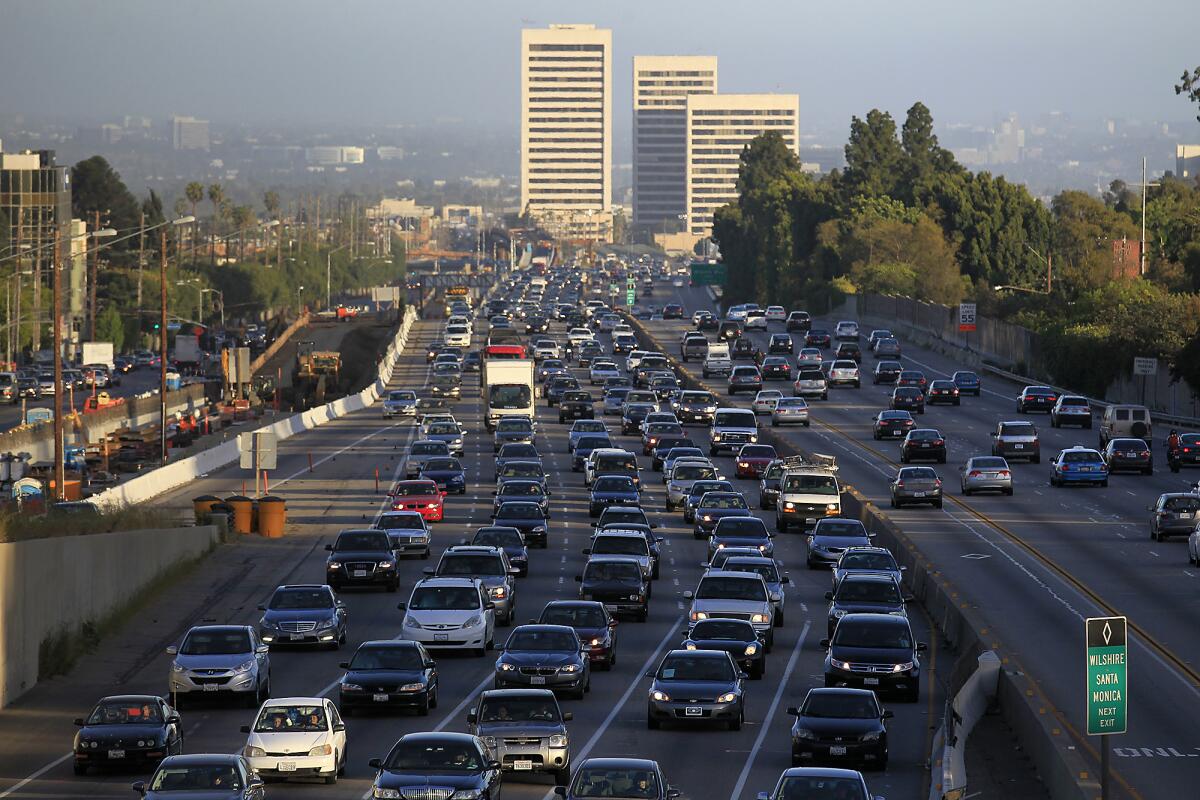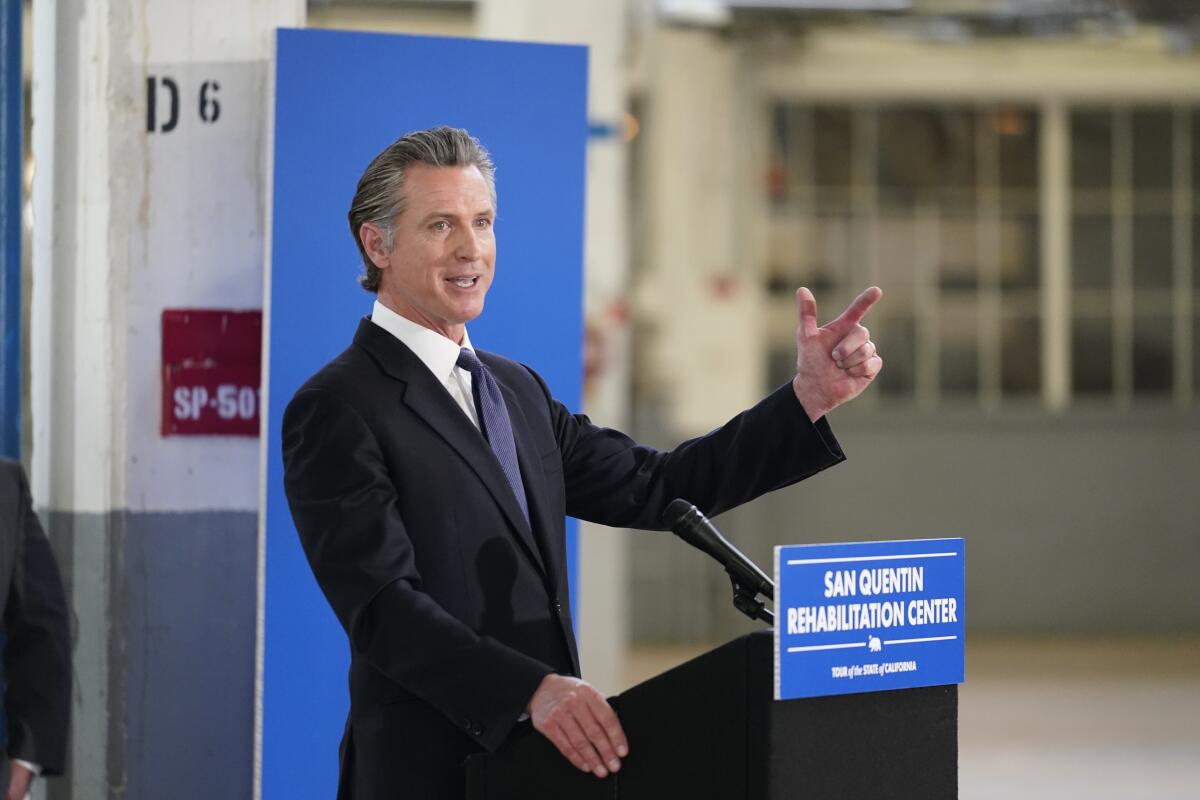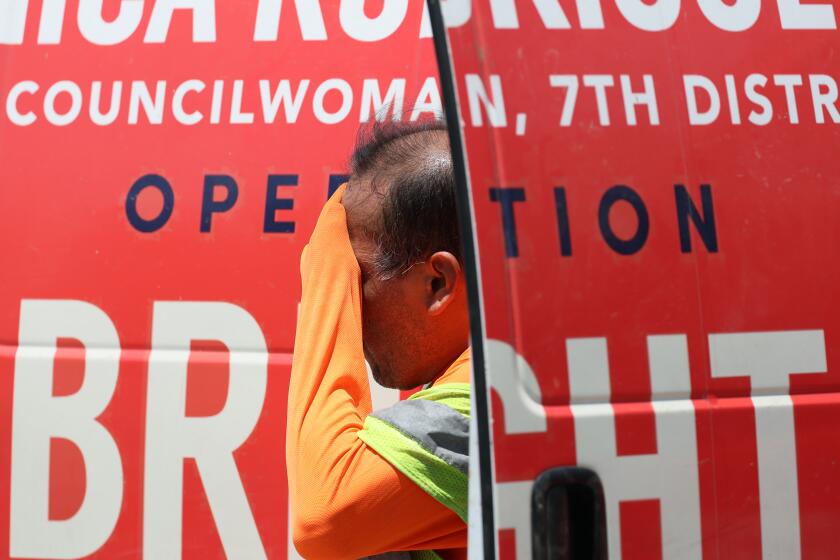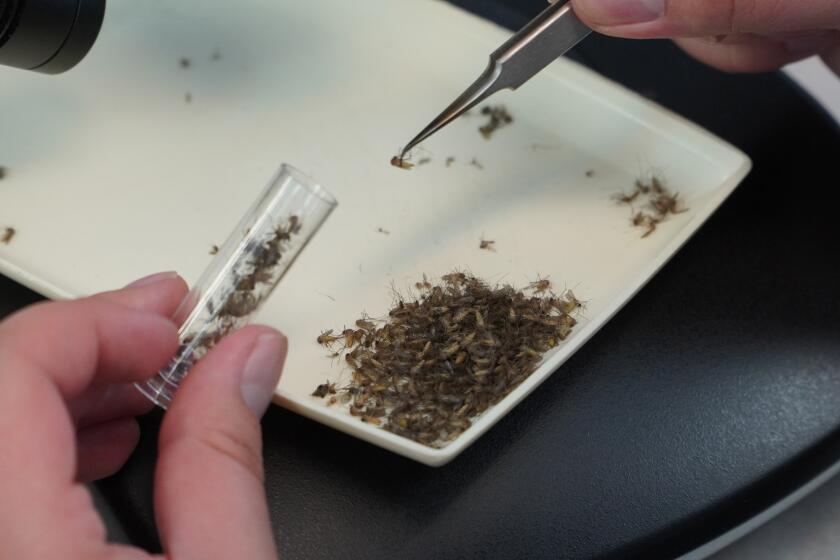Boiling Point: In Southern California, the water drama never dies

Drought or no drought, El Niño or La Niña — the Golden State’s water warriors always find a way to make life interesting.
The latest drama is playing out at the mighty Metropolitan Water District of Southern California, which buys water from Northern California and the Colorado River on behalf of 19 million people across Los Angeles, Orange, Riverside, San Bernardino, San Diego and Ventura counties. As my L.A. Times colleague Ian James reports, the agency’s board of directors voted unanimously last week to put its general manager, Adel Hagekhalil, on administrative leave amid accusations of sexism and harassment.
For the record:
12:34 p.m. June 18, 2024This story incorrectly stated, based on reporting from another news organization, that the U.S. Bureau of Reclamation has sided with Oregon ranchers in a Klamath River Basin water dispute. The agency has actually sided against the ranchers.
Some environmentalists worry the decision could have ripple effects on regional water policy.
You're reading Boiling Point
Sammy Roth gets you up to speed on climate change, energy and the environment. Sign up to get it in your inbox twice a week.
You may occasionally receive promotional content from the Los Angeles Times.
Hagekhalil has championed efforts to safeguard Southern California against climate change-fueled drying trends by investing in more resilient local water supplies, including captured stormwater, cleaned-up groundwater and recycled wastewater.
That’s led some environmentalists to speculate that the accusations against Hagekhalil could be part of a nefarious plot to derail his local water agenda and secure support for traditional water infrastructure — possibly including Gov. Gavin Newsom’s planned $20-billion tunnel beneath the Sacramento-San Joaquin River Delta, which could ease the flow of water from NorCal to SoCal.
Adán Ortega Jr., who chairs Metropolitan’s board and shares Hagekhalil’s policy goals, has rejected such speculation.
In a written statement, he said the decision to put Hagekhalil on leave was “made to allow time to investigate various personnel matters,” and that “conspiracy theories and speculation about allegations are harmful to the investigative process.”
What might be happening behind the scenes? Ian explored the competing claims in this follow-up story.
The city of Los Angeles — one of the Metropolitan Water District’s largest customers — is dealing with its own drama.
In a startling investigation co-published by AfroLA, the Guardian and Inyo County’s The Sheet, Katie Licari sheds new light on L.A.’s long history of misdeeds in California’s Owens Valley. More than a century after the city’s infamous water grab, Licari reveals that its continued ownership of most of Inyo County’s private land “has taken on a new, and crippling, dimension.”
In recent years, Licari writes, the Los Angeles Department of Water and Power “has taken steps to exert even greater control over its land holdings in the valley,” making it harder for lease holders to transfer their leases to new owners starting in 2016.
The result? “DWP’s moves have meant that hundreds of families who have built lives in the Eastern Sierra region have seen their plans upended, often being left with the stark choice of abandoning their livelihoods or fighting DWP,” Licari writes.

I asked Janisse Quiñones, DWP’s new chief executive, about the investigation when we spoke last week.
To her credit, Quiñones said she was researching the issue and had asked her team to look into it.
“That’s not who we want to be, or who we are,” she said. “I’ve got to figure out how we make better [for people in the Owens Valley]. When we talk about social justice, they are also part of our social justice strategy.”
In better news, the Colorado River’s Lower Basin states are pulling less from Lake Mead. Circle of Blue’s Brett Walton reports that California, Arizona and Nevada used 13% less Colorado River water last year than in 2022 — their lowest draw since 1983.
We definitely need to keep using less water overall, though — both to deal with climate-fueled aridification in the American West and to confront the reality of the usual El Niño-La Niña swings. As my L.A. Times colleague Hayley Smith reports, there are strong odds of a La Niña developing in the Northern Hemisphere this year, which could bring drier weather to Southern California.
New Mexico’s oil and gas industry has an idea for boosting the state’s insufficient drinking water supplies — why not use treated wastewater produced by fossil fuel drilling? Intriguing, except that state regulators say it may be too dangerous for public health, per Martha Pskowski at Inside Climate News. Officials are open to using oil and gas wastewater for industrial processes, though.
Back in California, meanwhile, parts of our coastline aren’t in great shape — often because of too much water.
A San Francisco grand jury has concluded the city is woefully unprepared for the ever-more-powerful floods being caused by fossil fueled climate change, as storms get more intense and sea levels creep upward. Details here from The Times’ Hayley Smith.
In Santa Barbara County, extreme storm damage has kept Refugio State Beach closed for months — and the climate crisis could bring worse flooding, The Times’ Ben Poston reports. Farther south, the Surfrider Foundation ranked San Diego County’s Imperial Beach — where toxins flow north from the Tijuana River — America’s most polluted beach, Alene Tchekmedyian writes.
Before we move on from water to other topics, two river stories:
- Some environmentalists are worried that Pacific Gas & Electric could delay the removal of two dams on California’s Eel River, creating dangerous conditions for native fish. Other conservationists aren’t so worried. (Sage Alexander, Times-Standard)
- The U.S. Bureau of Reclamation is siding against Oregon ranchers who argue that federal officials don’t need to comply with the Endangered Species Act when doling out water from the Klamath River Basin. (Michael Gennaro, Courthouse News Service)
On that note, here’s what else is happening around the West:
THE ENERGY TRANSITION

I’ve made two reporting trips to Utah’s Millard County, where Intermountain Power Plant has for decades supplied coal-electricity to Los Angeles and several other Southern California cities. The next time I visit, the coal plant will be gone — probably.
A few months ago, Utah Gov. Spencer Cox signed a bill designed to save Intermountain, even though elected officials in and adjacent to Millard County urged him not to, reporting by the Salt Lake Tribune’s Bryan Schott reveals. Per Schott’s reporting, local officials understand that attempting to rescue the coal plant could run afoul of federal regulations, jeopardizing L.A.’s efforts to replace it with a new facility running on fossil gas and green hydrogen — and throwing the region’s economic future into doubt.
Those nuances were seemingly lost on Cox — an unfortunate reminder that even when fossil fuel communities understand that the world is changing, and show they’re willing to change with it, political ideologues can still be swayed by simplistic arguments about how Democrats want to kill coal, and make decisions that hurt rather than help the people who elected them.
I’m relatively more encouraged by Wyoming Gov. Mark Gordon, who joined billionaire Microsoft co-founder Bill Gates in a rural coal town to celebrate the first major construction milestone for an advanced nuclear power plant that Gates hopes to build. Details here from WyoFile’s Dustin Bleizeffer. The sodium-cooled reactors are still a ways off. But progress is progress.
In other coal news, Canary Media’s Julian Spector reports that Colorado-based Tri-State Generation and Transmission is acquiring its first big solar plant, part of a shift to renewable energy for the coal-heavy rural electric cooperative. Colorado’s Moffat County, though, could be economically devastated by the closure of one of Tri-State’s coal plants, as well as two coal mines. Local officials want a state agency to require Tri-State to provide up to $118 million in aid, the Colorado Sun’s Mark Jaffe reports.
In Nevada, the Las Vegas Review-Journal’s Sean Hemmersmeier writes that federal officials finished the environmental review for Greenlink West, part of a $4.24-billion series of power lines proposed by Berkshire Hathaway’s NV Energy that could help transmit renewable energy across the region, but which some conservationists worry would trample wildlife habitat and public lands.
Also in Nevada, some conservation groups say the proposed Rhyolite Ridge mine — designed to produce lithium for electric car batteries — would destroy 22% of critical habitat for an endangered wildflower called Tiehm’s buckwheat, Wyatt Myskow reports for Inside Climate News. Meanwhile, a senior official at the federal Bureau of Land Management warned in an internal email that the federal government might be rushing the mine’s environmental review, Hannah Northey reports for E&E News.
Let’s return to California to close things out.
State officials have approved reforms they say will make it easier to get solar farms and batteries hooked up to the power grid faster — a pressing need with not much space left on the grid. Here’s the story from Utility Dive’s Ethan Howland.
In the Legislature, a bill would make it easier for utility companies to transition neighborhoods from gas heating and cooking to electricity. The legislation has passed the Senate and awaits a vote in the Assembly, Canary Media’s Jeff St. John reports.
Let’s say you love clean energy and electrification, but would rather see it carried out by public agencies than by investor-owned utilities such as Southern California Edison and Southern California Gas? Alas, one of your best chances to see more of the state go the public route just flopped. The San Diego Union-Tribune’s Rob Nikolewski reports that San Diegans won’t be able to decide on a public takeover of San Diego Gas & Electric following a unanimous vote by the City Council not to put it on the ballot.
Before we move on from energy, two gas-fired power stories:
- Amazon has scrapped a plan to power data centers in eastern Oregon with fossil gas. (Mike Rogoway, the Oregonian)
- Arizona is letting a gas plant expand without the usual environmental review, critics say. (Russ Wiles, Arizona Republic)
HOW WE GET AROUND

As I discussed in a newsletter earlier this year, we’ve known for nearly a century that building and expanding freeways does little to nothing to reduce traffic. It merely induces more driving, leading to more traffic — and more air and climate pollution.
To limit traffic and pollution, we need to drive less — which is why it’s so discouraging that New York Gov. Kathy Hochul abruptly halted a first-in-the-nation plan that would have charged drivers entering Lower Manhattan during busy times of day.
Transportation experts have long seen “congestion pricing” as one of the best ways to reduce the number of people on the roads during peak driving hours. They’d hoped New York’s program would prove out the concept for Los Angeles County and other local governments that have studied but not gotten especially close to trying it out, my L.A. Times colleague Ryan Fonseca writes.
But now that Hochul has put New York City’s congestion pricing program on pause, seemingly fearful of a political backlash, who knows if and when it will happen in the United States. Her decision goes to show the continued power of car culture.
As long as we’re talking traffic, I sure hope the Automated People Mover solves the traffic nightmare that is Los Angeles International Airport, aka LAX. Here’s the story from The Times’ Colleen Shalby. All I can say is, 2028 can’t come fast enough.
In better news, the state of the electric vehicle market is strong, according to the experts at market research firm BloombergNEF. EVs made up 18% of global passenger car sales last year, as The Times’ Russ Mitchell reports. It’s not so clear if Orange County EV maker Fisker will be part of the long-term picture, though, amid continued struggles, per The Times’ Laurence Darmiento.
One more totally wild transportation tidbit?
There were supposed to be no new fossil fueled big rigs granted access to California’s ports starting in January, under a landmark air-quality rule approved by state officials. But in reality, 1,200 diesel trucks have joined the ranks this year at the notoriously hazy ports of Los Angeles and Long Beach because the Biden administration has been sitting on a waiver request since April 2023.
Don’t believe me? Here’s the story from my L.A. Times colleague Tony Briscoe.
POLITICAL CLIMATE

Remember when I griped a few months ago that the California Department of Finance was blocking the state’s first heat illness prevention standards for indoor workers from taking effect, objecting to the department’s argument — that the standards were too expensive for taxpayers — as ludicrous in an era when heat exposure is the deadliest consequence of climate change?
Well, now we’ve got an update: Gov. Gavin Newsom just dumped one of the state workplace safety board members who slammed his finance department for delaying the heat protections — delaying them so long, in fact, that they weren’t in place for this year’s first heat wave. Newsom also demoted the workplace safety board’s chair, who was similarly critical.
Here’s the story from CalMatters’ Jeanne Kuang.
I’m not sure what Newsom’s doing. But it’s discouraging.
I’m also confused by Newsom’s pitch to reduce the budget deficit by cutting $50 million for dam repairs — money that could help stave off unlikely but potentially dangerous failures, and also allow us to safely store more water behind dams. (Details here from Rachel Becker at CalMatters.) This seems like the kind of money we could very much regret not spending down the road.
Also in Sacramento, a bill that would give California voters a chance to establish a constitutional right to clean air, clean water and a healthy environment by way of the ballot box won’t advance this year, amid opposition from the Chamber of Commerce. Even in the Golden State, public health and the environment don’t always win, as The Times’ Hayley Smith reports.
Lest we need to be reminded what’s at stake, California’s biggest wildfire of the year is currently burning in northern L.A. County, fueled by heat-dried grasses, the growth of which exploded after two wet winters — the kind of climate whiplash that’s a hallmark of global warming, as my L.A. Times colleagues Grace Toohey, Hayley Smith and Joseph Serna report. Also see these photos of the Post fire by The Times’ Robert Gauthier, Jason Armond and Gina Ferazzi. As of Monday, the blaze had exceeded 15,000 acres.
Knowing how dangerous wildfire smoke and extreme heat can be for human health, should the Federal Emergency Management Agency recognize them as “major disasters” and hand out disaster relief funds to help communities cope? FEMA changed its rules for COVID, and several dozen groups are asking the agency to do the same for climate. Here’s the story from Hayley Smith.
One other step government could take to help people cope with worsening fires? Making it easier to get home insurance in fire-prone neighborhoods. California is trying to do that; state regulators just released a list of which ZIP Codes insurers will have to cover if they want an easier path to charging higher rates. Some consumer watchdogs don’t think it’s a good strategy, though, worried that insurance companies will get too much in exchange for too little, as The Times’ Laurence Darmiento reports.
As always, not everything is gloomy.
Hayley Smith reports that Long Beach City College is getting $9.5 million in funding from President Biden’s Inflation Reduction Act to help the L.A. area build a climate-ready workforce. The money will support training, internships and jobs in water and solar.
It’s also possible that a new mountain lion has moved into P-22’s old territory in L.A.’s Griffith Park. The Times’ Lila Seidman wrote about efforts to make the region more cougar-friendly, including construction of a wildlife crossing over the 101 Freeway.
In one of the week’s most positive stories, the San Francisco Chronicle reported on the largest restoration project in Yosemite National Park’s history, at a meadow near Hetch Hetchy Reservoir. It was previously private rangeland; now it’s “a vibrant hub of wildflowers, songbirds and water-loving grasses,” Kurtis Alexander writes. Check out the photos, too.
Before we wrap up, a few final Western stories:
- Voters in California’s Solano County will get a chance to decide on California Forever, a huge new community being pitched by its billionaire backers as a walkable, solar-powered, sustainable city of the future. (Jessica Garrison, Los Angeles Times)
- The nonprofit Environmental Defense Fund will spend millions of dollars researching geoengineering: artificially cooling the planet. EDF isn’t endorsing the technology, but it will explore possible side effects. The decision comes after the California city of Alameda blocked a first-of-its kind geoengineering test. (Christopher Flavelle and Soumya Karlamangla, New York Times)
ONE MORE THING

I had a great time talking with my L.A. Times colleague Judeh the Sheep Puppet (brought to life by master puppeteer Safi Nazzal) about Joshua trees, solar farms and climate change. Also, if you missed it, you can read my column on that topic here.
This column is the latest edition of Boiling Point, an email newsletter about climate change and the environment in California and the American West. You can sign up for Boiling Point here. And for more climate and environment news, follow @Sammy_Roth on X.
Toward a more sustainable California
Get Boiling Point, our newsletter exploring climate change, energy and the environment, and become part of the conversation — and the solution.
You may occasionally receive promotional content from the Los Angeles Times.




